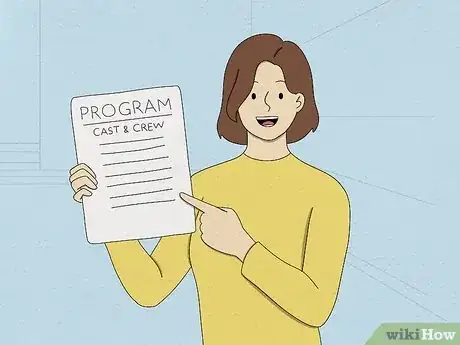This article was co-authored by wikiHow Staff. Our trained team of editors and researchers validate articles for accuracy and comprehensiveness. wikiHow's Content Management Team carefully monitors the work from our editorial staff to ensure that each article is backed by trusted research and meets our high quality standards.
There are 8 references cited in this article, which can be found at the bottom of the page.
wikiHow marks an article as reader-approved once it receives enough positive feedback. In this case, 100% of readers who voted found the article helpful, earning it our reader-approved status.
This article has been viewed 51,729 times.
Learn more...
From musical theatre, to improv theater, to traditional Greek drama, there are a million kinds of play to produce. Each kind of production demands different preparations. You may start with a script, or you may start with a location and write or find a script that makes the most of it. Maybe you have a group of actors already in mind, and would like to pick a play that flatters their abilities. What matters is that you begin with a vision and that you follow through with it.
Steps
Gathering Your Thoughts and Your Crew
-
1Choose a script. The script is the document that contains all the lines and stage directions of a play. It defines act and scene changes, descriptions of the characters and ideas for staging.[1] You can write your own play, or you can use a script from an established playwright.
- If you are putting on a musical, you will also need to buy or compose the score (a document containing music that goes with the play).
- To find potential scripts, visit the Plays section in your local bookstore. You can also search online for free scripts.
- You can save money by putting on a play that was written over a hundred years ago, such as a play by Shakespeare. Such scripts can be found online for free, and are not owned by a publishing house, meaning you do not have to buy the rights to produce them.[2]
- If you are putting on an improvised play, or a play with no words, you will still need to write down the basic ideas of your play, and note things like scene changes and number of actors involved.
- Obtain copies of the script your every member of the cast and crew, and get a few backups.
-
2Buy the rights. To buy the rights to a play, look up its publishing house. Find their catalogue online, or contact them to ask for a catalogue, to learn the royalty fee. Some plays are "restricted," meaning not available for production. Once you are sure the play is unrestricted, contact the publishing house and ask for a quote. If you perform the show without a license, then you are doing what is called an illegal production. [3]
- To get a quote, provide the publishing house with the play's title, the intended venue and its seating capacity, the organization that is producing the play, the projected ticket prices, and the performance dates. Make sure to indicate whether or not you are a for-profit group, and if you are in the actor's union.
- You will be contacted with a quote and a contract, or simply an invoice.
- You will have to purchase scripts and scores separately.
Advertisement -
3Find a venue. Find a location that goes well with your script and your vision. Look at local theaters and get price quotes. Traditional theaters a stage, rows of cushioned seats, light and audio equipment, changing rooms and mirrors, access to restrooms, a curtain, storage for props and scenery, and a green room for actors to rest. Outdoor theaters, such as Greek amphitheaters and stages in parks, are excellent options for more casual productions. However, if you would like to stage your chosen play by this approach, you might want to consult the weather forecast in your local area.
- Public and private schools, colleges, churches, and community centers often have theaters that can be rented.
- Consider staging in an unorthodox location, such as an empty warehouse, a park, or a private home.
- When picking unorthodox locations, aim for a place with good acoustics, the right amount of space for the action you imagine, plenty of comfortable seating for your audience, and access to restrooms.
- Consider: how will you control the lighting in your space? Will you need to rent equipment?
- What will serve as your "backstage" area? Where will actors go when they are not in the action?
- Consider finding a venue you can also rehearse in. If you cannot afford to rehearse in the venue you have chosen for the performance, find a separate venue to rehearse in. This venue should have an area about the same size and shape of the stage you will eventually perform on.
-
4Assemble a crew. A play needs a producer, who oversees the financing and management of the play, and a director, who has ideas of how the production will be seen infront of the audience as well as runs rehearsals. It needs people in charge of creating, finding, and keeping track of the costumes, the makeup, masks and wigs, the sets (backdrops, large objects such as fake cars or trees), and the props (objects to be handled onstage). It needs a stage manager, the person running the cast and crew from behind the curtains. Finally, it needs people to design the lights, and to handle the lights and the microphones that will be used during the show.
- Depending on the size of the production, you can have different people for each of these roles, or just a few people with overlapping roles.
- A large Broadway musical might have a crew of hundreds, while a school play might have a single person acting as producer, director, stage manager, and costume designer.
-
5Put out a casting call. Audition actors to take part in your play. If you already have actors in mind, give them a private audition, or just ask if they would like the part. If you don't have actors in mind, put up notices in your local paper and on community bulletin boards advertising the auditions. Describe each character, and the type of person you are looking to cast. For example, if you were trying to cast Romeo and Juliet, you would write "Juliet: young woman, any age considered but must be able to play 13-yo.
- Be sure to list how many actors you are casting, whether or not you are offering compensation, how frequent rehearsals will be, and when the play will be performed.
- List where and when auditions will be held, what the actors should bring, and your contact information.
-
6Audition and cast your actors. The producer and director should have each actor read lines from the script for the parts they want. You can audition each person separately, or you can call in all the Juliet's at once and have them read one after another. You can also have actors audition with a monologue they have prepared ahead of time.
- You may need to read the lines in between, or you may want to have another actor on hand to read with the person auditioning.
- Get the contact information of each actors so that you can inform them whether or not they got the parts they wanted.
- Once you have a few options for each roll, offer callbacks. Callbacks are a separate audition in which the actors you are considering for the part return and audition again.
- Once you have cast the play, contact all the actors and let them know if they are in or not. If you have bit parts (small roles with no lines or just a few lines) available, ask the actors you did not cast if they would be willing to play these parts.
- Bit part actors do not always need to come to every rehearsal, but still get to enjoy some time onstage during the production.
Rehearsing the Play
-
1Do a first read-through. Once you have your cast assembled, sit them all down in your rehearsal venue and have them read through the script. Lead a discussion about your vision for the play, and get thoughts from the actors. Discuss the significance of each scene, and clarify the meaning of each line.[4]
- Discuss the characters. Talk with each actor about the character he or she is playing. Have this actor think up a back story for the character, and establish how the character feels about the other characters in the play.[5]
- Explain the cast what the set will look like.
- Agree on a rehearsal schedule, and set expectations for when lines will be memorized.
-
2Block the play and rehearse with the script. Determine where, roughly, each actor will be on stage in even moment of scene—this is called "blocking" the play. Have the actors write down the blocking in their scripts, and write it in your own. Start by rehearsing with the script. The director should keep a copy of the script on hand at all times. When an actor forgets a line, he/she can say "line" and the director will provide a reminder.[6]
- If you are producing a musical, you will need a choreographer who designs the dances for each song. This blocking is much more involved.
- When blocking, consider the set design. Put tape down on the stage where the curtain will be, where the set pieces will be, and where spotlights will be, and make sure all the actors what part of the stage is what.
-
3Rehearse in stages. Run through scenes, run through whole acts, and run through the entire play. Give notes after each rehearsal. After a scene has been practiced, or after a whole act has run, the director should give notes and run through troubled moments. Discuss what scenes are going really well, and what needs to change. Your notes should provide specific guidance.
- For example, instead of saying "Romeo, you aren't acting like you're really in love. You look bored onstage," say "Romeo, we need to work on body language. When Juliet is on stage, you should always be facing her. Don't take your eyes off her—she is totally captivating to you."
- Run through scenes that aren't going well, giving actors specific tips. For instance, after giving Romeo his notes, have Romeo and Juliet go onstage to run just the few lines that weren't going well.
- Block detailed movement to guide lackluster acting: "Okay Romeo, when Juliet moves, follow her movements. Juliet, I want you to lift your arm on that line—okay, Romeo, take a step in that direction when she lifts her arm. Imagine you're a puppy playing catch!"
-
4Hold tech and dress rehearsals. As the date of the performance approaches, begin dress rehearsals. Dress rehearsal is a rehearsal in which the play is practiced exactly as it will be performed, from beginning to end. Actors should be in full costume and makeup. All the set pieces should be in place, and all the lighting and sound should be too. This is a chance for you to make sure that all the materials of the play are in place.
- Have a separate tech run-through in which the stage manager gives the cues for each scene change, and the technical crew performs the light and set changes necessary.
- Do a few of these to ensure speed.
- Have several dress rehearsals in which you stop the action to give notes and work out problems with sets, costumes, and lights.
- Once those things seem to be working, do one or two full run-throughs in which the whole play is performed, start to finish, with no stopping.
- If there is an error in staging, lighting, or acting, the cast and crew must work to cover it up, just as they will during an actual production.
Staging the Show
-
1Gather props. Props are the objects that are handled by actors onstage. They can range from food, to purses, to fake guns, to a Papier-mâché head. Depending on the size of your production, you will either have a single person in charge of props, or a props crew headed by a props manager.
- Go through the script with your props manager and write down every object that will be needed. Make note of when it will be needed.
- Make sure the props fit into the time period and social class implied by the script. For instance, when Romeo drinks poison, he shouldn't drink it out of a plastic water bottle, as those did not exist in the 1300s.
- Make sure your actors know when in the script they will be handling certain objects, and have them rehearse with them or with stand-in objects when possible.
- Your props can be purchased, built, or donated.
- During the performances, actors can retrieve their own props, or members of the props crew to bring the actors what they need. The props manager should keep track of where the props are at all times.
-
2Assemble the set. Some plays come with suggested set designs, but some require you to design your own. Make sure the layout of your set is in place before you begin rehearsals, so that your actors know where to move onstage. Some plays have elaborate sets, while some rely on the imaginations of the viewers.
- If you are performing inside, your set might include painted backdrops or a screen that images are projected across.
- Your set can also include furniture and built objects that actors can stand or sit on. Romeo and Juliet, for instance, requires a balcony.
-
3Make or rent the costumes. Your costume manager might rent, purchase, sew, or borrow the costumes used throughout the play. Go through the script together and determine what each character should be wearing in each scene.[7] Mark the costume changes and make sure the actors knows when they will have to change costumes.
- Members of the costume crew may be needed to help effect rapid costume changes between scenes.
- If a costume must be changed quickly, consider investing in costumes that can be removed quickly, using zippers or velcro rather than laces and buttons.
Performing the Play
-
1Advertise. In the weeks before a play opens, advertise in local papers and message boards. Design an eye-catching image to use on posters, in ads, and on flyers. You can repeat this image on the program for your play, if needed.[8]
- Send actors in full costume to local schools, retirement communities, or public places to perform bits and pass out flyers.
- Make sure your advertisements say when the play will be performed, and where.
- If you are having multiple performances, indicate this prominently.
- Consider offering a matinee, or daytime performance, with discounted tickets for children and the elderly.
-
2Sell tickets. If you are financing or defraying the cost of your show through ticket sales, calculate how many tickets you need to sell, and at what price. Encourage your actors and tech crew to sell slightly discounted tickets to friends and family. Set up a website where patrons can buy tickets before the show begins.
- Designate someone to sit at the door and sell tickets before the show starts.
-
3Set up house. For your performance, make sure that the theater is clean and ready. Consider printing a program in which you list the cast and crew by name, in which you give thanks to everyone involved in the production of your play. Consider selling ads in the program to raise money. Thank your sponsors if you have any, and include interesting facts about your theater company and the play you have produced.
- Consider selling concessions. If your show has an intermission, sell the audience members candy, chips, coffee, and, if you have a permit, alcoholic beverages.
- Make sure you have permission from the venue to sell concessions.
- Consider hiring ushers to help audience members to their seats. Ushers can also pass out flyers and direct people to the restrooms.
-
4Perform. Savor the excitement of your opening night. Gather cast and crew together before the first show and give a speech of thanks and encouragement. Answer any questions, and remind everyone of recent changes or issues. Do some team-building activities, such as having everyone hold hands in a huge circle and chanting.
- After each performance, or before the next performance opens, give notes to your cast and crew.
- If you are only doing one performance, skip the notes and just dole out praise and thanks.
Community Q&A
-
QuestionHow do I get people to find out about my play?
 Community AnswerYou can put up posters around town or hand out flyers at a public place. You could even pay for a newspaper advertisement.
Community AnswerYou can put up posters around town or hand out flyers at a public place. You could even pay for a newspaper advertisement. -
QuestionHow do I put on a play where only I am in it?
 Community AnswerThere are many actors who have put on one-man shows. Use costumes and sets that require minimal changing time. Use dolls or mannequins to represent the other characters.
Community AnswerThere are many actors who have put on one-man shows. Use costumes and sets that require minimal changing time. Use dolls or mannequins to represent the other characters. -
QuestionWhat if I don't have a venue or local theater? How would I show it to people?
 Community AnswerYou could choose to show it in a local park or even in your driveway or on the sidewalk. Where ever there is enough space. If it's on your driveway you could use the garage for changing and stuff and if you're in the park you could bring along a tent or two for changing.
Community AnswerYou could choose to show it in a local park or even in your driveway or on the sidewalk. Where ever there is enough space. If it's on your driveway you could use the garage for changing and stuff and if you're in the park you could bring along a tent or two for changing.
References
- ↑ http://www.theatrecrafts.com/pages/home/topics/stage-management/glossary-directing/
- ↑ https://fairuse.stanford.edu/overview/public-domain/welcome/
- ↑ https://copyright.lib.utexas.edu/perform.html
- ↑ https://www.nyfa.edu/student-resources/how-to-analyze-a-script-for-actors/
- ↑ https://www.nyfa.edu/student-resources/how-to-analyze-a-script-for-actors/
- ↑ https://awesomestagemanager.wordpress.com/2012/02/29/blocking/
- ↑ https://digitalcommons.liberty.edu/cgi/viewcontent.cgi?article=1469&context=honors
- ↑ https://www.stagemilk.com/how-to-market-a-theatre-show/














































































